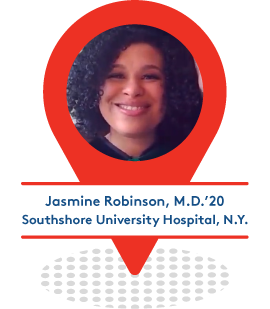 Finding Joy
Finding Joy
Jasmine Robinson, M.D.'20,
keeps artwork from her seven-year-old daughter close during her days as
a obstetrics/gynecology resident at Southshore University Hospital in
Bay Shore, New York. It’s a grounding force during a fraught and
frenetic time.
“I always have a picture that my daughter
drew,” she says. “I’ll tape it to my computer or carry it in my
planner—just to kind of remind me of the things that bring me joy.”
In
an overwhelming year, the goal was to learn as much as possible while
also coming to terms with a new role and expanded scope of
responsibility.
“I think this year is mostly getting used to
being called ‘Doctor,’” says Robinson. “And kind of owning that title,
because there is a lot of impostor syndrome that still follows you into
residency.”
She began her year on labor and delivery, which
meant a whirlwind of competing demands. COVID-19 added another dimension
to the rotation, as in certain emergent situations she wouldn’t always
know right away if a patient being treated for a complication from
pregnancy was also positive for the virus.
“It’s quick,
there’s a lot of things happening at once,” she says. “There’s
emergencies… there’s urgent C-sections. It’s pretty heavy in terms of
the amount of work and multitasking that you have to do.”
Before
the vaccine rollout, Robinson said she felt grateful for the widespread
availability of PPE and other precautions already in place at the
hospital, allowing her to avoid some of the worry very early on in the
pandemic about protection for front line workers. As the pandemic grinds
on, she’s finding the balance she needs to be at her best for her
patients.
“I figured out during this year what makes the
most sense for me, in terms of taking on too many things, taking on too
many projects, overextending myself in ways that I know might be
detrimental in the long run,” she says. “Residency is definitely a very
humbling experience, where you have to recognize your own limitations
and the things that you need in order to continue at the same pace.”